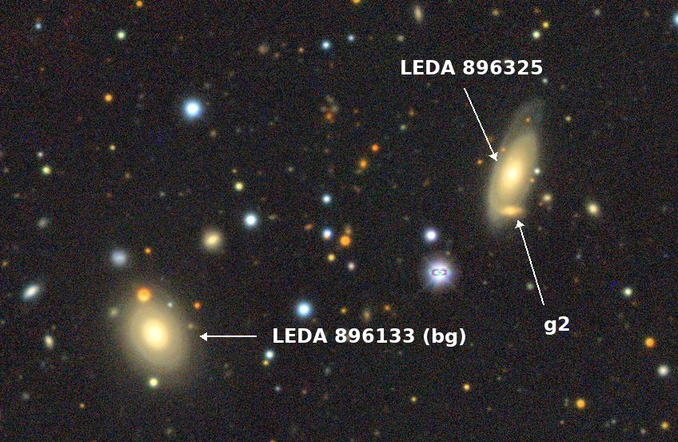Astronomy Object of the Month: 2025, September
< previous Archive next >
Spirals can do it, too – a spiral host in a 2 Mpc double-double lobed radio galaxy
Extragalactic jets, which are among the most powerful astrophysical phenomena,
are collimated streams of gas ejected at high speeds from astronomical objects, in
particular active galactic nuclei (AGNs). They can create huge clouds of matter
bright at radio wavelengths, extending far beyond the boundaries of their host
galaxy. If such sources reach sizes larger than 0.7 megaparsecs, we call them Giant
Radio Galaxies (GRGs). Here we present an unusual object of this kind – a radio
source J1350-1634 with two visible pairs of lobes, hosted by LEDA 896325 – the
largest GRG hosted by a spiral galaxy known to date.

The radio map of J1350-1634. The red and blue colours represent 200 MHz GLEAM and 1400 MHz NVSS images, respectively. The outer and the inner lobes, as well as the core and the background objects ('bg', 'bb', 'bc', 'bd') are marked with yellow. The pictures in the lower left corner show the DESCal DR-10 optical image and the 8.65 GHz VLBI contour map of the central region with LEDA 896325 galaxy.
LEDA 896325 is unique in several ways. First of all, the occurrence of giant radio lobes associated with spiral galaxies is extremely rare - such structures are usually hosted by massive, gas-poor elliptical galaxies with little star formation. J1350-1634 extends to 2 megaparsecs in linear size. To confirm the galaxy’s morphology, two modelling approaches have been applied using the Dark Energy Spectroscopic Imaging Survey data. Both models clearly show disk-like and spiral features.
Moreover, J1350-1634 is a double-double lobed radio source. Jets usually remain active for at most tens of millions of years. However, some galaxies exhibit more than one episode of jet activity, leading to a formation of multiple lobes. In J1350-1634 two pairs are visible: the north-eastern and south-western outer and inner lobes. The energy fluxes at several radio wavelengths made it possible to estimate their age: 120 and 35 million years for the outer and the north-eastern inner lobes, respectively. We need more detailed radio observations to investigate the possibility of a third activity episode.
An important property of AGNs is the presence of a supermassive central black hole. The spectral data for LEDA 896325 make it possible to study the stellar velocities in the galaxy, which indicate the black hole mass of 240 millions of solar masses. This supports the idea that large black hole mass plays a key role in jet launching mechanisms.

The DESCal optical DR-10 image of LEDA 896325 and its surroundings.
The surrounding environment and external interactions also appear to be important factors. Many radio-loud spiral active galaxies reside in galaxy groups or clusters. In the optical images we find two extended objects located nearby LEDA 896325, labelled ‘bg’ and ‘g2’ in Figure 2. However, the distance to ‘g2’ remains unknown, while recent studies suggest that ‘bg’ and LEDA 896325 are not gravitationally bound. Observations suggest that the environment of LEDA 896325 is relatively sparse. We need further investigation to clarify this issue.
This discovery shows that not only elliptical but even star-forming spiral galaxies can create large radio structures under appropriate conditions. Moreover, they can undergo episodic jet activity. Yet there are some questions that still need to be answered: what mechanism enables a spiral to ignite such powerful jets and why are such systems so uncommon?
Original publication: Sagar Sethi, Agnieszka Kuźmicz, Dominika Hunik & Marek Jamrozy, Serendipitous discovery of a spiral host in a 2 Mpc double-double lobed radio galaxy, Astronomy and Astrophysics, 699 (2025).
The research described is part of the research topics conducted at the Department of Stellar and Extragalactic Astronomy of Astronomical Observatory of the Jagiellonian University in Kraków. This work was supported by the Polish NSC (grant 2018/29/B/ST9/01793) and the Poland's high-performance Infrastructure PLGrid (ACK Cyfronet AGH) within computational grants PLG/2024/016935 and PLG/2025/017961.
|
Sagar Sethi Astronomical Observatory Jagiellonian University Sagar.Sethi [at] doctoral.uj.edu.pl |


